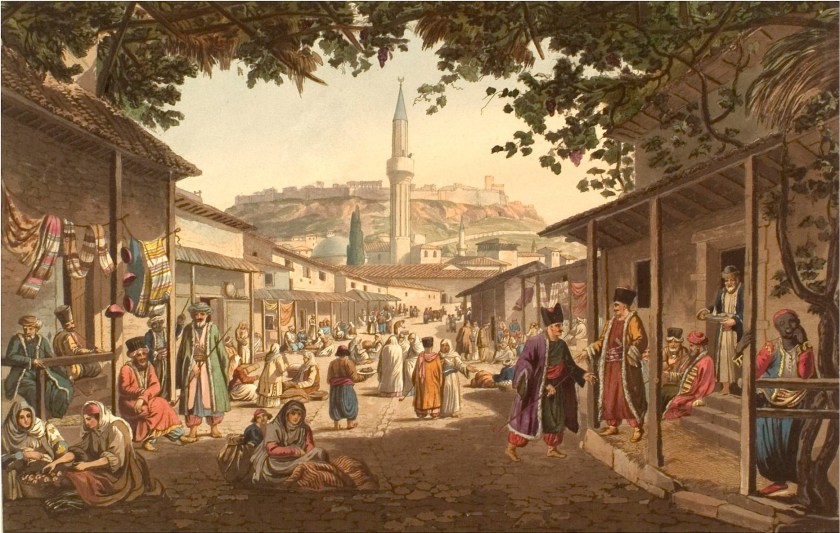As a follow up to my post Old Athens, I thought I’d write a few words about Edward Dodwell (1767 – 1832), an Irish painter, traveller and archaeologist, who travelled widely in Greece, making exquisite paintings in the process.

Edward Dodwell was born in Dublin to an ancient and wealthy Irish family, and studied Classics and Archaeology at Trinity College, Cambridge. Being in possession of a large fortune and free from professional commitments, he dedicated himself to the study of Mediterranean cultures.

Dodwell travelled from 1801 to 1806 in Greece, which was then a part of the Ottoman Empire.
In 1801 he sailed to the Ionian Islands and the Troad with Atkins and the well-known traveller William Gell. In 1805 he visited continental Greece in the company of the painter Simone Pomardi, during which time they produced almost one thousand illustrations. These bring to life a vanished world that, since then, have enchanted European travelers and inspired their passionate pursuit of classical antiquity.

“Almost every rock, every promontory, every river, is haunted by the shadows of the mighty dead,” Dodwell wrote, conveying with aesthetic sensitivity the discovery of each place, the journey of exploration of an unknown landscape; and managing to combine monuments, history, and contemporary life.
Dodwell’s paintings contain an immense wealth of information on Greek public and domestic life during the years before the War of Independence. He was often invited to stay in the houses of prominent Greeks.

Apart from archaeological issues, he wrote about the dances, music and games of the Greeks, as well as about local insects and birds.
His observations are varied – he notes, for example, the presence of a number of black slaves in the town of Patras and elsewhere, writes of Ali Pasha’s extortions, and lists the products peculiar to each region.

Dodwell was in Athens in March 1805, while Lord Elgin’s crews were pillaging the sculptures of the Acropolis monuments.

Dodwell published A Classical and Topographical Tour through Greece (1819); Views in Greece, with thirty colored plates (1821); and Views and Descriptions of Cyclopian or Pelasgic Remains in Italy and Greece (1834). These books are still of value to archaeologists today.

He subsequently lived in Naples and Rome, and married a woman thirty years his junior. Unfortunately he caught an illness and died in 1832, while exploring the mountains of Italy. His large archaeological collection, of coins, 115 bronzes and 143 vases, kept for a time in his house in Rome, was later sold to the Munich Glyptothek.


These are beautiful images of what ancient Greece might have looked like. There are many other artists who specialize in researching and painting old and long gone cultures. I’m grateful to these places through their talent.
LikeLiked by 1 person
There’s something wonderfully evocative about his painting of the village of Portaria. As I read, I kept whipping back to have another look at it.
LikeLiked by 1 person
This was an enjoyable and edifying read Marina. The detail in his paintings is remarkable for what it reveals.Now I must find out more about the Elgin marbles.
LikeLiked by 1 person
They’re very revealing paintings. I’m assuming that they’re accurate, given his enthusiasm for archaeology.
LikeLiked by 1 person
They’re supposed to be… He was the original urban sketcher!!!😊
LikeLiked by 1 person
Thanks M.L. Kappa for introducing me to Dodwell. I had never come across him and am most taken by his watercolours. Love the one in Tower of the Winds, and Athen’s bazaar. I felt I was walking there again in some strange time-shift. How different life is today.
LikeLiked by 1 person
Isn’t it? I’m so glad you enjoyed it. 🌺
LikeLike
A good introduction to someone I had not heard of
LikeLike
Thanks, Derrick, I thought people might enjoy this🌺
LikeLiked by 1 person
Beautiful paintings, and an enjoyable and informative post.
LikeLike
Thank you, I’m glad you enjoyed it🌹
LikeLike
Reblogged this on Art Scene Athens and commented:
A wonderful piece from the blog ‘Letters from Athens’, on Dodwell and his artistic investigation of Greece
LikeLiked by 1 person
Thank you for the reblog! 🌺
LikeLiked by 1 person
Very interesting post! I like to see old paintings of places I have visited.
LikeLiked by 1 person
Thank you, Georgie, I’m glad you enjoyed it!
LikeLike
Those paintings are amazing, a glimpse back in time.
LikeLike
Hi Marina, Thank you for bringing back the eras of ancient Greece. The paintings are absolutely wonderful and it originally depicts life in Greece many decades ago. It is wonderful and thank you for posting
LikeLiked by 1 person
I’m so glad you enjoyed it 😊
LikeLiked by 1 person